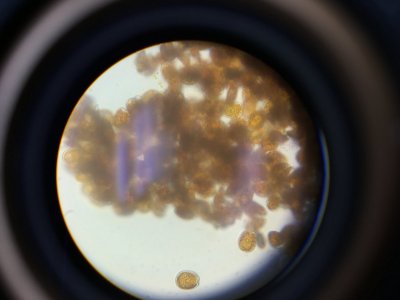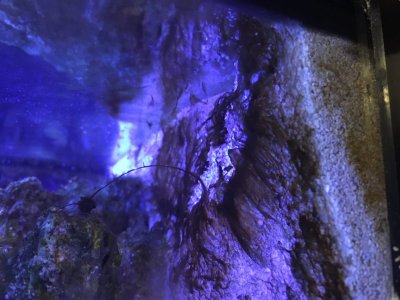@Ernie Crucet Oh yea those are them, thank you for the clearer picture.
What are your plans to take them down?
What are your plans to take them down?
Follow along with the video below to see how to install our site as a web app on your home screen.
Note: This feature may not be available in some browsers.
@Ernie Crucet Oh yea those are them, thank you for the clearer picture.
What are your plans to take them down?
Yes they are.I can’t see them too clearly but they look like mine which are ostreopsis

Hello! Wondering if anyone might be able to help me
I've been battling dinos since about January. At first I thought it was cyano or diatoms but as weeks progressed and I did my weekly water change, the algae grew insanely worse (I've now learned dinos love water changes).
For the past month or so, my local reef store owner has been graciously helping me with the issue, but he has me doing blackout after blackout (I've done 4) to absolutely no avail. We did discover I was buying RO water for my tank, and not RO/DI water, so I bought an RO/DI unit about a month ago to fix that problem, which he thought would fix the dinos , this also didn't work. The blackouts help but a few weeks after the blackout, the dinos come back with vengeance. He advises me to do more blackouts, but they aren't working. His advice unfortunately is only putting a bandaid on my problem I think, so I've come here for help.
I was hoping to get an ID on my dinos, I very much assume they are large cell amphidinium dinos, based on what I've researched but wanted advice from reefers that seem to have extremely helpful advice on dealing with dinos and giving a proper ID (and possible advice on how to start fighting them to get rid of them?)
The images included are what my dinos look like under a microscope. I also included what they look like in the tank.
Nitrates are registering at 5 PPM and Phos is about 0.1 (trying the dirty method currently).


An ID would be amazing if possible so I can try and figure out how to tackle this, thanks in advance!
Hi MegHello! Wondering if anyone might be able to help me
I've been battling dinos since about January. At first I thought it was cyano or diatoms but as weeks progressed and I did my weekly water change, the algae grew insanely worse (I've now learned dinos love water changes).
For the past month or so, my local reef store owner has been graciously helping me with the issue, but he has me doing blackout after blackout (I've done 4) to absolutely no avail. We did discover I was buying RO water for my tank, and not RO/DI water, so I bought an RO/DI unit about a month ago to fix that problem, which he thought would fix the dinos , this also didn't work. The blackouts help but a few weeks after the blackout, the dinos come back with vengeance. He advises me to do more blackouts, but they aren't working. His advice unfortunately is only putting a bandaid on my problem I think, so I've come here for help.
I was hoping to get an ID on my dinos, I very much assume they are large cell amphidinium dinos, based on what I've researched but wanted advice from reefers that seem to have extremely helpful advice on dealing with dinos and giving a proper ID (and possible advice on how to start fighting them to get rid of them?)
The images included are what my dinos look like under a microscope. I also included what they look like in the tank.
Nitrates are registering at 5 PPM and Phos is about 0.1 (trying the dirty method currently).


An ID would be amazing if possible so I can try and figure out how to tackle this, thanks in advance!
Uv sterlizer for ostreopsis will work best along with adding biodiversityAbout to start a dr Tim’s refresh and waste away treatment tomorrow for ostreopsis.
Do I need to black the tank out for 3 days? Or is this treatment effective without the black out?
Lastly I have a bunch of green film algae on the glass, I haven’t scraped it to compete with the dinos. Should I leave it prior to a blackout if one needs to happen during treaent? The dinos seem to be growing on this film now though.
Thank you so much everyone!
I was hoping to get an ID on my dinos, I very much assume they are large cell amphidinium dinos, based on what I've researched ...
The images included are what my dinos look like under a microscope. I also included what they look like in the tank.
An ID would be amazing if possible so I can try and figure out how to tackle this, thanks in advance!
Everything I have read has advised pods and phyto are the best course of action, they are the number one competitor to dino
Now what I’m not sure and can use some advice if I should do or not...
- continue to Dose phytoplankton daily?
Great post.I'm curious what the source is advocating pods and phyto vs dinos. If the dinos are toxic, then they kill off the pods at very small Dino cell concentrations.
Secondly the dino mucus mats are very good at trapping small invertebrates such as pods, and also phyto. The mucus mats themselves often contain toxins and most things that come in contact with them die and their decomposition fuels the dino bloom further.
The next objection is size. When we by phyto, we are buying usually 5 Micron cells. Our problem dinos average around 50 microns long. So the things that grow by eating the live phyto, are poorly suited to try to eat the problem Dino cells. The pods that are sold, are typically also the wrong kind for this job. Much larger pods such as munnid isopods and amphipods are actually capable, and are often found in and around problem Dino blooms in our tanks. The pods typically bought, are copepods which again are just too small for the job. See my previous picture of a copepod covered in mucus mat and prorocentrum Dino cells.
I have tried to carefully observe Dino blooms in my systems as they rise and especially fall. Organisms that I have seen grazing on dinos during the phase where the outbreak is receding include isopods, amphipods, tanaid shrimp, some snails for low toxin blooms, multiple different classes of ciliates, but not copepods. I've posted pics/ vids of these before.
If phyto/ pod sellers have upped their game and are selling a better suited offering, than the normal Live 5 to 10 Micron phyto and copepods I'd be interested to know.
I do like a good story, especially one with a happy ending.Story Time:
I had Dinos(Ostreopsis) in my 66g tank, after adding a UV sterilizer and biodiversity they were gone. I recently purchased a new tank (130g) that was previously running, came with all the live rock and sand. After moving my livestock and coral over to the new tank i noticed dinos only on the sand bed, appears to be ostreopsis again and is likely a result of the sand bed being stirred when I moved the tank. I moved my UV from my old tank to my new one, and it appears to be holding them at bay, but i'm going to begin dosing Microbactor7 in hopes of eliminating them. What i found most interesting was what began happening in my old tank, as i left it running, since i planned to sell it as a running tank.
Since I ignored the old tank Dinos began to come back, the rear wall was absolutely coated in Dinos and it was over the rocks. I didn't really care because there was no livestock or coral in the tank. A few weeks passed and i noticed it starting to go away and the rear walls were absolutely covered in pods, i'm talking thousands and many massive ampipods. They completely ate all of the dinos, and other algae. The tank was literally a pod paradise. There was no predators and they were out during the day and night. I firmly believe pods are a very good answer to dinos.
Story Time:
I had Dinos(Ostreopsis) in my 66g tank, after adding a UV sterilizer and biodiversity they were gone. I recently purchased a new tank (130g) that was previously running, came with all the live rock and sand. After moving my livestock and coral over to the new tank i noticed dinos only on the sand bed, appears to be ostreopsis again and is likely a result of the sand bed being stirred when I moved the tank. I moved my UV from my old tank to my new one, and it appears to be holding them at bay, but i'm going to begin dosing Microbactor7 in hopes of eliminating them. What i found most interesting was what began happening in my old tank, as i left it running, since i planned to sell it as a running tank.
Since I ignored the old tank Dinos began to come back, the rear wall was absolutely coated in Dinos and it was over the rocks. I didn't really care because there was no livestock or coral in the tank. A few weeks passed and i noticed it starting to go away and the rear walls were absolutely covered in pods, i'm talking thousands and many massive ampipods. They completely ate all of the dinos, and other algae. The tank was literally a pod paradise. There was no predators and they were out during the day and night. I firmly believe pods are a very good answer to dinos.
Some dealers sell them but usually come in on LR and frags.Do you plan on leaving UV on permanently? What size/kind UV are you using? Anyone know where to buy amphipods?
I surprisingly found some on amazon.Some dealers sell them but usually come in on LR and frags.
